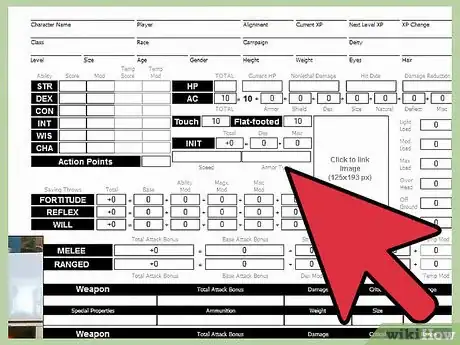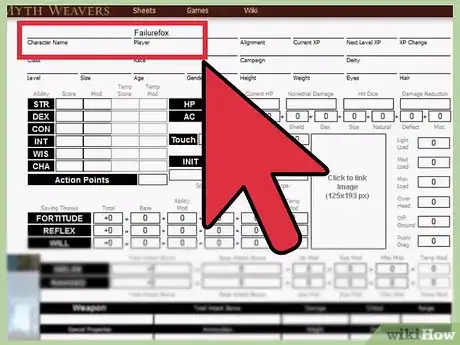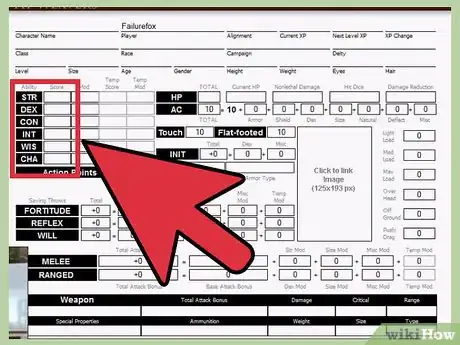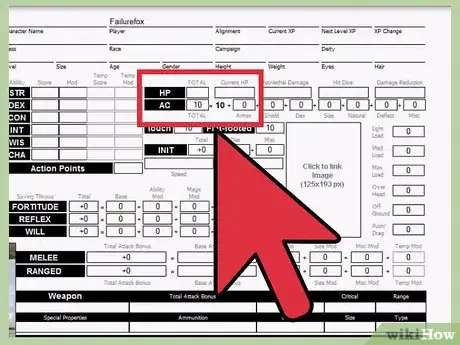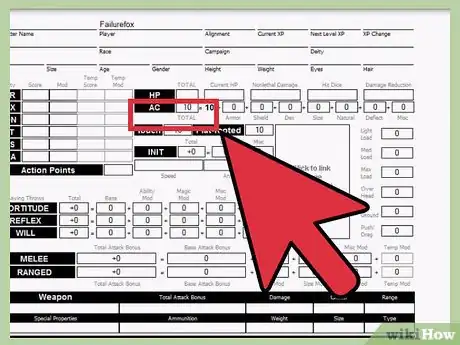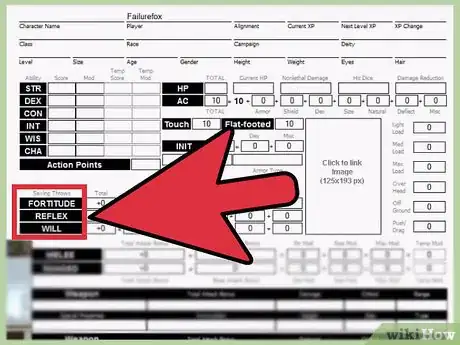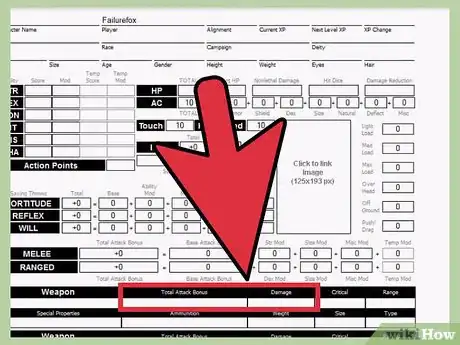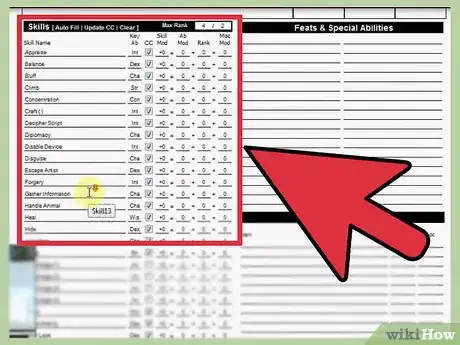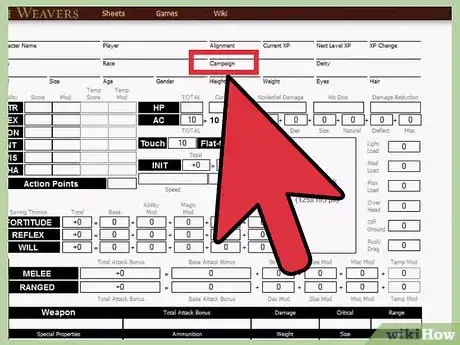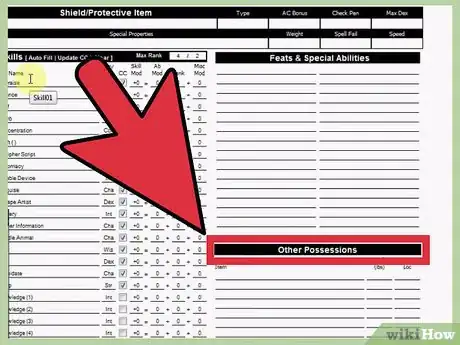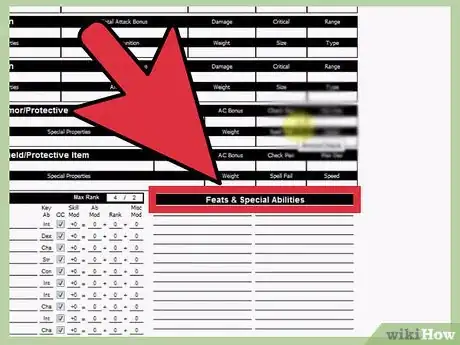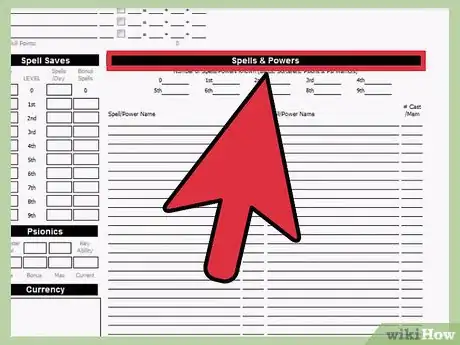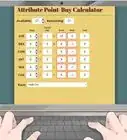Explore this Article
IN THIS ARTICLE
Other Sections
X
wikiHow is a “wiki,” similar to Wikipedia, which means that many of our articles are co-written by multiple authors. To create this article, 15 people, some anonymous, worked to edit and improve it over time.
This article has been viewed 114,006 times.
Learn more...
Let’s face it: the game of Dungeons and Dragons has a lot of information that players need to keep track of for their own characters. Regardless of class, there are dozens of numbers, items, and traits that a single character may possess. There's no need to worry, though—we've outlined everything you need to successfully fill out your character sheet, so you can get started with your awesome campaign.
Steps
1
Gather materials.
-
To complete the character sheets, make sure you have the following:
- at least one of every basic type of die (d4 (4-sided die), d6, d8, d10, d12, and d20)
- a copy of the player’s handbook for D&D 3.5
- a copy of the character sheets (found in the back of the handbook)
- the six starting ability scores for your character (found in Chapter 1 or by consulting your DM)
- a pencil
Advertisement
2
Fill out basic character information.
-
The top section of the first page is all up to your personal tastes.
- Character Name: Choose a good name!
- Player: This will be your name.
- Class and level: The class is chosen by you in Chapter 3. The starting level is determined by the DM, but is generally first level.
- Race: This is chosen by you in Chapter 2.
- All other features: These are personal choices made by you during character creation. Be realistic. Consult Chapter 6 for advice on how to choose these traits.
3
Fill out Ability Scores.
-
Take your prepared ability scores and write them into the “ability score” column. Write them next to their corresponding ability. This score should include the base score and any additional modifiers (such as a racial bonus). The ability modifier in the next column is calculated by subtracting ten from the ability score, dividing the remainder by two, and rounding down.
- For example, an ability score of 15 would have a +2 ability modifier (15-10 = 5, 5/2 = 2.5, rounded down = +2).
- Your DM may have you use the temporary score and modifier columns during your adventure, but for right now leave them blank.
Advertisement
4
Fill out HP, Speed, and AC.
-
HP stands for “hit points," which is how much damage your character can take. Speed is how quickly your character can move in a single action during combat. AC stands for “armor class” and describes how hard your character is to be hit by attacks.
- HP: Your total HP (hit points) is calculated by rolling your class’ hit die (noted in the class description in the player’s handbook) and adding your constitution modifier to it. This is done upon attaining each new level. At first level, however, your character receives the full hit die and constitution modifier worth of points. A rogue, for example, with a hit die of d6 and a constitution modifier of +2 would receive 8 hit points at first level and would roll a d6 and add 2 HP for each subsequent level.
- Wounds/Current HP: This area will be used to keep track of your characters HP during the game. You can use it to count up damage received or use it to count down your characters HP. In the beginning, you should have full HP.
- Nonlethal Damage: This area can remain blank, as your character is at full HP.
- Speed: Your character’s speed is noted under your race in Chapter 2 of the Player’s Handbook. Generally, this is 30 feet (9.1 m). Certain things in the game, such as items, encumbrance, or class features, may modify your speed.
- AC: Your AC is calculated by Armor Bonus (from worn armor), Shield Bonus (from wielded shields), Dex Modifier (Dexterity Modifier), Size Modifier (noted in Chapter 2 under your race), Natural Modifier (attained later in the game, but generally unavailable at first level), Deflection Modifier (AC bonuses through magical items), and Misc Modifiers (anything not covered in the previous categories).
- Damage Reduction: Consult your DM to determine if your character has any.
5
Fill out Touch AC, Flat-Footed AC, and Initiative.
-
Touch and Flat-Footed ACs describe special situations in the game. These situations are where an attack simply needs to make contact (touch) or your character is caught unawares (flat-footed). These attacks are generally easier to pull off and are calculated differently. Initiative represents how quickly your character responds to battle and is used to modify a d20 roll to determine turn order in combat.
- Touch AC: This value is your AC without Armor, Shield, and Natural Bonuses.
- Flat-Footed: This value is your AC without the Dex Modifier added.
- Initiative: This value is your Dex Modifier plus any Misc Modifiers (such as the feat Improved Initiative).
Advertisement
6
Fill out Saving Throws.
-
Fortitude, Reflex, and Will Saves are used to represent the resilience of a character to certain conditions in the game. Fortitude, for example, is used to show toughness against punishment and poisons. Reflex Saves could be used to avoid a magical explosion. Will Saves could save your character from being mind-controlled by an evil sorcerer. Each of them are calculated by adding up the following numbers:
- Base Save: This value is located on the corresponding leveling chart of your character’s class in Chapter 3. A level one fighter, for example, has a +2 Fortitude, +0 Reflex, and a +0 Base Will Save.
- Ability Modifier: This value comes from the corresponding ability. For Fortitude, use the Constitution Modifier. For Reflex, use the Dexterity Modifier. For Will, use the Wisdom Modifier.
- Magic Modifier: This value comes from any active spells of magical items on your character.
- Misc Modifier: This value comes from anything not covered in the previous categories (such as feats or racial traits).
- Temporary & Additional Modifiers: Leave blank for now.
7
Fill out the Base Attack Bonus (BAB), Spell Resistance, and Grapple.
-
Your character’s base attack is what you will use in combat (with other stats) to determine the success of your attacks. Spell resistance shows how much defense your character has against unwanted magical effects. Grappling is a method of combat in which you grab your foe.
- Base Attack Bonus: This value is located on the corresponding leveling chart of your character’s class in Chapter 3. A level one fighter, for example, has a +1 BAB.
- Spell Resistance: This box can be left blank at this time. Your DM will inform you if you need to fill it.
- Grapple: This value is found by adding your character’s BAB, Strength Modifier, Size Modifier (found under your race in Chapter 2), and any Misc Modifiers (such as from feats or class features).
Advertisement
8
Fill out the Attacks.
-
Each box here represents a form of attack for your character. These may be with a melee weapon (like a sword), a ranged weapon (like a bow), or a natural weapon (like a punch).
- Attack: This is the type of weapon being used (sword, bow, etc).
- Attack Bonus: This is total bonus you will add to a d20 roll to determine the success of your attack. This includes the BAB, corresponding ability modifier (strength for melee or natural, dexterity for ranged), and any Misc Modifiers (such as bonuses provided by the weapon or feats).
- Damage, Critical, Range, Type, and Notes: These can be found in the corresponding weapon description in Chapter 7.
- Ammunition: This is where you will keep track of the type of ammo for your weapon and the amount you have on your character.
9
Fill out the Skills.
-
Your character is defined in no small way by the things he or she can do besides attacking. This area is used to keep track of the prowess of your character in performing other actions in the game. Certain skills are class skills (actions your class are proficient in doing) and cross-class skill (actions that come harder as part of your class).
- Max Ranks: Your characters max class skill ranks will be his or her level +3. The max cross-class skill ranks will be half of the max class skill rank value.
- Class Skills?: Each box that is next to a class skill of your character should be marked. Check the corresponding class description in Chapter 3 to verify which these are.
- Blank spaces next to skills: These areas are to specify what the skill is in. For example, one skill may be Craft (Armor) and another may be Craft (Crossbow). Check skill description in Chapter 4 to learn more.
- Key Modifier: This describes the ability modifier that is important to this skill. Copy the corresponding modifier into the Ability Modifier column.
- Skill Modifier: This value is calculated by adding up the Ability Modifier, Ranks, and Misc Modifier.
- Ranks: These are purchased using skill points upon advancement to a new level. Each class gets a certain number of new skill points plus their intelligence modifier. This can be found in the corresponding class description in Chapter 3. A sorcerer, for example, gains 2 skill points plus his or her Int Modifier per level. At first level, this value is multiplied by four. These points may be spent in any skill. One skill point buys one rank in a class skill. One skill point buys half of a rank in a cross-class skill. The total number of ranks in a particular skill may not exceed the values in the Max Ranks section.
- Misc Modifier: These are additional bonuses from sources other than Ability Modifiers and Ranks, such as racial traits or feats.
Advertisement
10
Fill out the Campaign and Experience Points.
11
Choose your Gear, Other Possessions, and Money.
-
Gear is essential to your character’s adventure. Consult your DM on what items and wealth your character will start with in the campaign. Consult Chapter 7 to purchase additional gear for your character.
- Gear: This area is used for armor, shields, and other items that provide protection. The information here can be copied from the corresponding description in Chapter 7 or from your DM in some circumstances.
- Other Possessions: This area is used for items other than those in the Gear area being carried by your character (this includes all weapons). Use the corresponding descriptions in Chapter 7 to fill out these entries (PG being the page number and WT being the weight of the item), adding up all of the total weight of both Gear and Other Possessions. The bottom section (Loads) is filled in using the beginning of Chapter 9 and your Strength Modifier. Lifts and Push are calculated as noted on the character sheet.
- Money: This area is used to note how much CP (copper pieces), SP (silver), GP (gold), and PP (platinum) your character is carrying. This is determined by following the instructions in your class description in Chapter 2 or by asking your DM.
Advertisement
12
Fill out the Feats, Special Abilities, and Languages.
-
These things help flesh out your character and bring it more to life.
- Feats: This spot is to make note of possessed feats and their pages in the handbook (Chapter 5). Characters at first level generally have just one.
- Special Abilities: This area is to note any characteristics of the character provided by your class or race. There is also a spot for the corresponding page number from the handbook.
- Languages: This area is to note any languages known by the character. Each character knows common, their racial languages (found in Chapter 2), and one additional language per +1 of Int Modifier.
13
Fill out the Spells Section.
-
The remainder of the character sheet is used for magic users. This area may be skipped by any classes that don’t use magic. For those that do use magic, proceed as follows.
- Spells: This area is to note the spells known or frequently used by your character.
- Spell Save & Arcane Spell Failure: These are explained in Chapter 10.
- Level section: This area is filled out using the corresponding class description in Chapter 3 and the magic chapter in Chapter 10.
Advertisement
Community Q&A
-
QuestionHow do I fill in the attack section of my character sheet in Dungeons and Dragons?
 Community AnswerYour attack is your Base Attack Bonus plus your Strength modifier plus any bonuses for feats, minus any penalties you might have. You add this number to the d20 to see if you hit. You'll also want to note the damage (weapon damage + STR modifier + any bonuses).
Community AnswerYour attack is your Base Attack Bonus plus your Strength modifier plus any bonuses for feats, minus any penalties you might have. You add this number to the d20 to see if you hit. You'll also want to note the damage (weapon damage + STR modifier + any bonuses). -
QuestionIs there a simple way to fill out a character sheet?
 Community AnswerThere are sites online that will auto fill your character sheets, excluding armor, weapons, monies, spells and such. I'd look around though, because some provide more information once they are printed off than others.
Community AnswerThere are sites online that will auto fill your character sheets, excluding armor, weapons, monies, spells and such. I'd look around though, because some provide more information once they are printed off than others.
Advertisement
Warnings
- This many take a lot of time, so you might want to do this prior to the night of the campaign⧼thumbs_response⧽
Advertisement
You Might Also Like
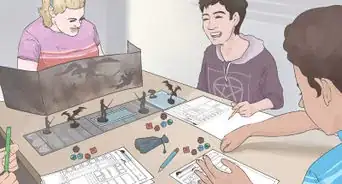 How to Create a Dungeons & Dragons V3.5 Character
How to Create a Dungeons & Dragons V3.5 Character
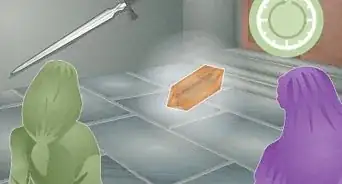 D&D Puzzles: Best Puzzles & Traps to Use in Dungeons & Dragons
D&D Puzzles: Best Puzzles & Traps to Use in Dungeons & Dragons

How to
Play Dungeons and Dragons
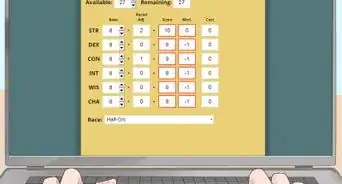 How to Roll Stats: Best Ways to Generate Ability Scores in D&D 5e
How to Roll Stats: Best Ways to Generate Ability Scores in D&D 5e
 How to Determine Saving Throws in D&D 5e: Game Rules & Calculation Tips
How to Determine Saving Throws in D&D 5e: Game Rules & Calculation Tips
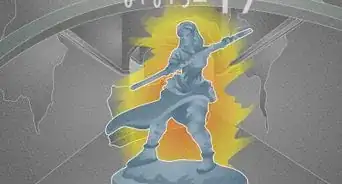 Beginner’s Guide to Spell Save DCs in D&D 5e (Plus How to Increase Them)
Beginner’s Guide to Spell Save DCs in D&D 5e (Plus How to Increase Them)
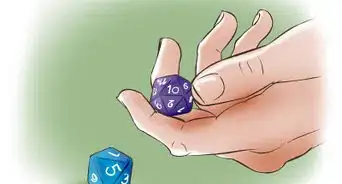
How to
Be a Dungeon Master

How to
Create a Dungeons and Dragons Campaign

How to
Create a Dungeons and Dragons World
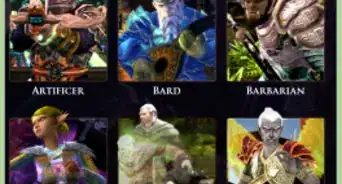
How to
Play Dungeons and Dragons for Free

How to
Create a Dungeon in D&D
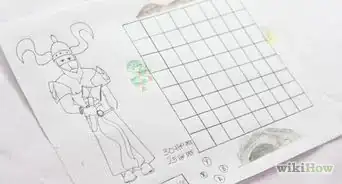
How to
Play Magick and Monsters
Advertisement
References
- Cook, M., & Tweet, J. (2003). Dungeons & dragons player's handbook: core rulebook I v.3.5. Renton, WA: Wizards of the Coast.
About This Article
wikiHow is a “wiki,” similar to Wikipedia, which means that many of our articles are co-written by multiple authors. To create this article, 15 people, some anonymous, worked to edit and improve it over time. This article has been viewed 114,006 times.
107 votes - 75%
Co-authors: 15
Updated: June 15, 2022
Views: 114,006
Categories: Dungeons and Dragons
Advertisement
